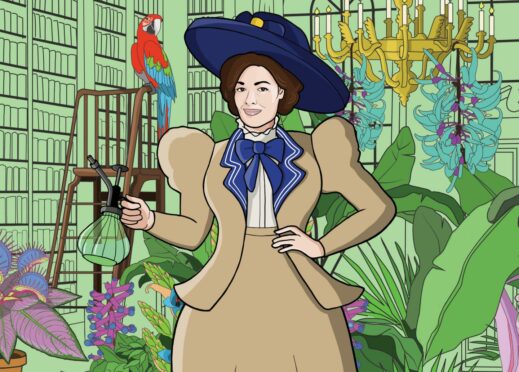Forensic science is no game – except when it comes to uncovering The Curse Of The Burial Dagger.
Scientists at Dundee University’s Leverhulme Research Centre have teamed up with storytelling experts Fast Familiar to create a new video game which aims to teach players the critical thinking and evidence skills used to solve real-life mysteries.
The Curse Of The Burial Dagger is an interactive graphic novel set in a fictional mansion just outside Dundee, where Lord Hamilton has been found dead with a “cursed” dagger from Ancient Egypt in his chest.
Over the course of 60-90 minutes, players will follow protagonist Susie as she tries to uncover what happened to her eccentric uncle, whittling down a Cluedo-esque cast of colourful suspects to reveal the killer.
And thanks to help from experts at Dundee’s own Leverhulme Research Centre, the game has been designed to help players aged 10 and up learn to think like a real forensic scientist.
Learn to think like a crime-busting scientist
According to Fast Familiar co-founder Rachel Briscoe, the game aims to encourage critical-thinking, rather than straightforward puzzle-solving.
“In games, there’s always a right answer,” explains Rachel. “Whereas in life, there isn’t someone there standing at the scene you’re investigating, saying: ‘Well done, that was the right thing, you found it.’
“So we were really interesting in creating an environment where players would need to use their critical thinking. I’m a massive crime fan myself, but sometimes it can be a bit cut-and-dry, and you think, ‘Really? Would it be that obvious?’”
The game uses a hypothesis system to get players thinking about different possibilities, rather than leading them to one answer, explains Leverhulme Centre’s Heather Doran.
“Within the game, the focus is on the hypotheses that are created. And then you’re looking at the elements that are either given to you, or things you have to work out through the puzzles,” she says. “And the players really have to think: ‘What is this telling me? What can I see here?’
“Forensic scientists often talk about piecing together things that have happened in the past. Part of their role is to go back and build up a picture.
“So it’s about fact-finding – they’re not there to create a story about what happened.”
Despite its basis in real techniques, the gameplay itself is simple, which picture or language-based codes to crack and puzzles to piece together, as well as conversations with other characters which reveal clues.
“Obviously within the game, there’s different types of puzzles and it is a fictional scenario, so it’s not a recreation of what forensic scientists are actually doing in the lab,” Heather notes. “But it’s that kind of thinking process that’s important.”
Getting hands-on, off-screen
However, for budding scientists who want to get more hands-on, the game comes along with links to education packs for teachers or parents, outlining basic experiments in chromatography, fingerprint analysis and other techniques used by labs to solve crimes.
“I remember doing chromatography things at school with the blob of ink and I loved it!” laughs immersive theatre creator Rachel. “I really like the idea that people could play the game and then they have the resources to do these experiments themselves.”
Plus, she goes on, the critical thinking skills employed in the game can be applied in many instances of daily life – including using the Internet.
“The game has a wider application, I think, because we do live in this age of disinformation and misinformation.
“So those skills around discerning: ‘What do I actually know? What’s true? What’s supporting that?’ are absolutely part of this game. But I think those are skills which all of us should be honing and applying as we go about our lives.”
And The Curse Of The Burial Dagger’s connection to Dundee appears in the game itself as well as its creation.
Dundee links in mysterious murder
“Place is important to us at LRCFS,” says Heather. “We’re based in Dundee and that’s important for us as a centre. So we like to engage with people across the city in all sorts of different creative ways.
“We definitely reflect Dundee and Scotland in the things that we create.”
To reflect the scientists’ home city, the murder mystery takes place in an Angus stately home, and harks back to women’s education in 20th Century Courier Country.
“There are references to things which are actually true,” adds Rachel.
“The sister of the murder victim, Struana, she studies botanical sciences. And it’s set in 1923 so you might think: ‘Could that have happened?’ But actually yes, that was a real course and women could study it at that time.
“There are lots of things in there like that, which are so rooted to the local area.”
Success was verdict for jury game
The Curse Of the Burial Dagger marks the second collaboration between Leverhulme scientists and developers Fast Familiar. The first, The Evidence Chamber, attracted players from around the globe last year.
The Evidence Chamber was an “immersive theatre experience where the audience took on the role of jurors in a case that was based in Dundee”, Rachel explains, and it started off with people playing in the real-life chamber of Dundee’s Sheriff Court.
When lockdown hit in 2020, the game moved online, with players joining from all over the world.
“It was just amazing to see someone in Canada, someone in Saudi Arabia and someone in Aberdeen discussing these questions about science and justice together,” reveals Rachel.
“We thought: ‘Wouldn’t it be cool if we could make something that young people or families could get involved in?’ That was how The Curse Of The Burial Dagger began.”
The Curse Of The Burial Dagger is available to download at the Fast Familiar website, priced from £20.



